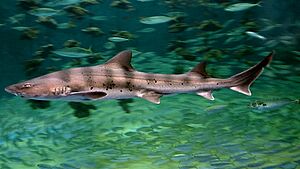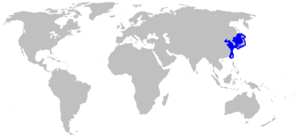Banded houndshark facts for kids
Quick facts for kids Banded houndshark |
|
|---|---|
 |
|
| Conservation status | |
| Scientific classification | |
| Genus: |
Triakis
|
| Species: |
scyllium
|
 |
|
| Range of the banded houndshark | |
| Synonyms | |
|
Hemigaleus pingi Evermann & Shaw, 1927 |
|
The banded houndshark (Triakis scyllium) is a type of houndshark. It lives in the northwestern Pacific Ocean, from the southern Russian Far East all the way to Taiwan. You can often find this shark near the ocean floor in shallow coastal areas. It likes places with sandy bottoms or lots of plants like seaweed. It can even live in brackish water, which is a mix of fresh and salt water. This shark can grow up to about 1.5 meters (5 feet) long.
It has a short, rounded snout and narrow fins. Its pectoral fins, which are like its front fins, are wide and shaped like triangles. The banded houndshark is gray on top and lighter underneath. Younger sharks have darker stripes and spots, but these fade as they get older.
This shark is mostly active at night and usually lives alone. It eats small animals that live on the ocean floor, like crabs and octopus, as well as small bony fishes. Female banded houndsharks give birth to live pups. They can have up to 42 babies after being pregnant for 9 to 12 months. The banded houndshark is not dangerous to humans. It also does well living in aquariums. Even though it's sometimes caught by accident by fishermen, its population seems to be stable. Because of this, the International Union for Conservation of Nature lists it as an Endangered species.
Contents
What's in a Name?
The banded houndshark was first described by two German scientists, Johannes Peter Müller and Friedrich Gustav Jakob Henle. They wrote about it in their book Systematische Beschreibung der Plagiostomen between 1838 and 1841. They named it scyllium, which comes from an old Greek word meaning "dogfish." They put it in the group of sharks called Triakis. This group also includes the leopard shark.
Where Do Banded Houndsharks Live?
Banded houndsharks are found in the northwestern Pacific Ocean. Their home range stretches from the southern Russian Far East down to Taiwan. This includes countries like Japan, Korea, and eastern China. They are quite common sharks.
These sharks live on the continental shelf, which is the shallow part of the ocean floor near land. They usually stay close to the shore, but they can also be found in deeper waters, up to 150 meters (about 490 feet) deep. They like sandy areas and beds of seaweed or eelgrass. They can also live in estuaries and bays, where fresh and salt water mix.
What Does a Banded Houndshark Look Like?
The banded houndshark has a fairly slim body. It can grow to be about 1.5 meters (5 feet) long. Its snout, or nose, is short, wide, and rounded. Its nostrils are far apart. Each nostril has a small flap of skin in front of it.
The shark's eyes are oval-shaped and sit high on its head. They have small protective eyelids, called nictitating membranes. The mouth is wide and shaped like an arch. It has long grooves at the corners. Each tooth is sharp, like a knife, with a main point and smaller points next to it. The shark has five pairs of gill slits, which it uses to breathe.
Most of its fins are quite narrow. The pectoral fins, located behind the gills, are wide and triangular in adult sharks. The first dorsal fin, on its back, is moderately tall. It's placed about halfway between the pectoral fins and the pelvic fins (which are near its belly). The second dorsal fin is smaller than the first but bigger than the anal fin (near its tail). The caudal fin, or tail fin, has a strong lower part and a notch near the top. Young sharks have a less clear lower tail fin. The shark is gray on top with darker stripes and black spots. These markings fade as the shark gets older. Its underside is off-white.
Life and Habits of the Banded Houndshark
Banded houndsharks are active at night. They usually prefer to be alone. However, sometimes several sharks might rest together, even piling on top of each other inside a cave.
They mainly eat crustaceans like shrimp, crabs, and hermit crabs. They also enjoy cephalopods like octopus and spoon worms. Sometimes, they eat other things like polychaete worms, tunicates, peanut worms, and small fish that live on the bottom. For younger sharks, shrimp and spoon worms are important foods. As they get bigger, cephalopods become a bigger part of their diet.
Mating happens during the summer months. The banded houndshark gives birth to live young. The baby sharks grow inside the mother, getting all their food from a yolk sac. Females usually have between 9 and 26 pups at a time. The pregnancy lasts for 9 to 12 months. Sometimes, a female can have as many as 42 pups!
In 2016, at the Uozu Aquarium in Japan, two pups were born in a tank that only had female sharks. This was a rare case where a shark reproduced without a male, a process called parthenogenesis.
Newborn pups are about 18 to 20 centimeters (7 to 8 inches) long. Male sharks are ready to mate when they are 5 to 6 years old and about 93 to 106 centimeters (37 to 42 inches) long. They can live up to 15 years. Females mature at 6 to 7 years old, when they are about 106 to 107 centimeters (42 inches) long. They can live up to 18 years.
Banded Houndsharks and People
The banded houndshark is not harmful to humans. You can often see them in public aquariums in China and Japan. They have even had babies while living in aquariums. Some have lived in captivity for more than five years.
Fishermen in Japan sometimes catch these sharks by accident in their gillnets. The meat is sometimes sold, but people don't think it tastes as good as other types of houndsharks. Fewer are caught off Taiwan, and they are probably fished in Korea and northern China too. In Japan, these sharks can sometimes find safe places in rocky areas where fishing is less common.
See also
Images for kids




